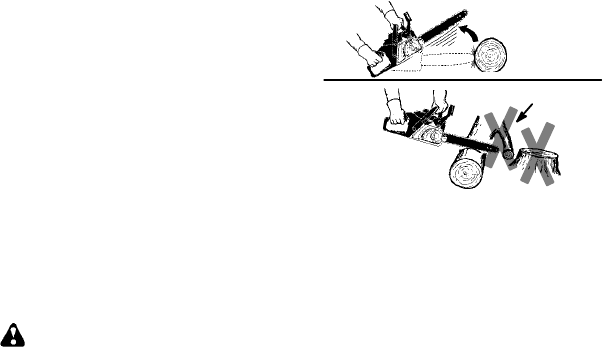
4
S Do not operate a chain saw that is dam-
aged, improperly adjusted, or not com-
pletely and securely assembled. Always
replace bar, chain, hand guard, or chain
brakeimmediatelyifitbecomesdamaged,
broken or is otherwise removed.
S With the engine stopped, hand carry the
chain saw withthe muffler away fromyour
body , and the guide bar and chain to the
rear, preferably covered with a scabbard.
MAINTAIN YOUR SAW IN GOOD
WORKING ORDER
S Have all chain saw service performed by a
qualified service dealer with the exception of
theitems listedin themaintenance sectionof
this manual. For example, if improper tools
are used to remove or hold the flywheel
when servicing theclutch, structuraldamage
to the flywheel can occur and cause the fly-
wheel to burst.
S Make certain th e saw chain stops moving
when the throttle trigger is released. For
correction, refer to CARBURETOR AD-
JUSTMENTS.
S Never modify your saw in any way. Use
only attachments supplied or specifically
recommended by the manufacturer.
S Keepthehandlesdry,clean, andfreeofoil
or fuel mixture.
S Keep fuel and oil caps, screws, and fas-
teners securely tightened.
S Use only McCullochR accessories andre-
placement parts as recommended.
HANDLE FUEL WITH CAUTION
S Do not smoke while handling fuel or while
operating the saw .
S Eliminate all sources o fsparks orflame i n
the areas where fuel is mixed or poured.
Thereshouldbenosmoking,openflames,
orworkthatcouldcausesparks. Allowen-
gine to cool before refueling.
S Mix andpour fuelin an outdoorarea on bare
ground; store fuel in a cool, dry, well venti-
lated place; and use an approved, marked
container for all fuel purposes. Wipe up all
fuel spills before starting saw.
S Move at least 10 feet(3 meters) from fuel-
ing site before starting engine.
S Turn the engine off and let saw cool in a
non-combustible area, not on dry leaves,
straw, paper, etc. Slowly remove fuelcap
and refuel unit.
S Storetheunitandfuelinanareawherefuel
vapors cannot reach sparks or open
flamesfrom waterheaters, electricmotors
or switches, furnaces, etc.
KICKBACK
WARNING: Avoid kickback which
can result in serious injury. Kickback is the
backward,upwardo rsuddenforwardmotion
of the guide bar occurring when the saw
chainneartheuppertip oftheguideb arcon-
tacts any object such as a log or branch, or
when the wood closes in and pinches the
sawchaininthecut.Contactingaforeignob-
ject in the wood can also result in loss of
chain saw control.
S RotationalKickbackcanoccurwhenthe
movingchaincontacts an objectat theup-
per tip of the guide bar . This contact can
cause the chain to dig into the object,
which stops the chain for an instant. The
result is a lightning fast, reverse reaction
which kicks the guide bar up and back to-
ward the operator.
S Pinch-Kickback can occur when the the
wood closes in and pinches the moving
saw chain in the cut along the top of the
guide bar and the saw chain is suddenly
stopped. This sudden stopping of the
chain results in a reversal of the chain
force used to cut wood and causes the
sawtomovei ntheoppositedirectionofthe
chain rotation. The saw is driven straight
back toward the operator.
S Pull-In can occur when the moving chain
contacts a foreign object in the wood in the
cut along the bottom o fthe guide bar andthe
saw chain is suddenly stopped. Thissudden
stopping pulls the saw forward and away
from theoperator and could easily cause the
operator to lose control of the saw.
Avoid Pinch--Kickback:
S Be extremely aware of situations orobstruc-
tions that cancausematerial to pinch the top
of or otherwise stop the chain.
S Do not cut more than one log at a time.
S Do not twist the saw as the bar is with-
drawn from an undercut when bucking.
Avoid Pull--In:
S Always begincuttingwiththeengineatfull
speed andthe saw housingagainst wood.
S Use wedges made of plastic or wood.
Never use metal to hold the cut open.
Kickback Path
Avoid Obstructions
Clear The
Working Area
REDUCETHECHANCEOF
KICKBACK
S Recognize that kickback can happen.
With a basic understanding of kickback,
you can reduce the element of surprise
which contributes to accidents.
S Neverletthemovingchaincontactanyob-
ject at the tip of the guide bar.
S Keep the working area free from obstruc-
tions such as other trees, branches, rocks,
fences, stumps, etc. Eliminate or avoid any
obstruction that your saw chain could hit
while you are cutting through a particular log
or branch.
S Keep your saw chain sharp and properly
tensioned. Alooseordullchaincanincrease
the chance of kickback o ccurring. Follow
manufacturer’s chain sharpening and main-
tenanceinstructions. Checktensionatregu-


















